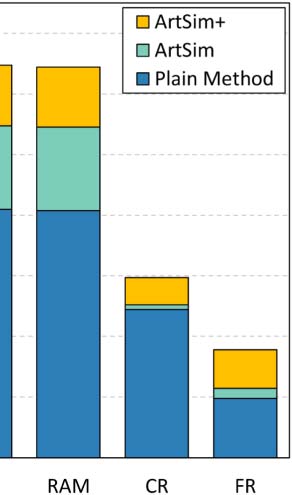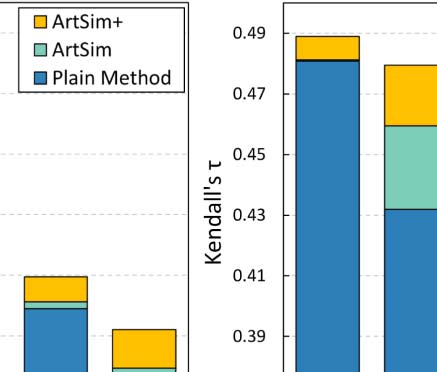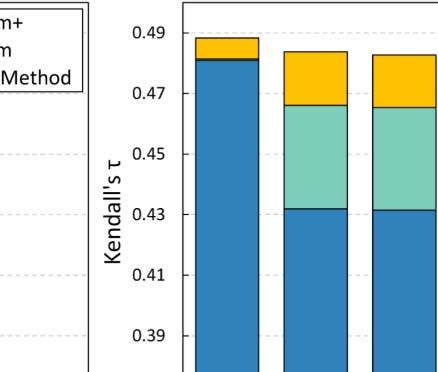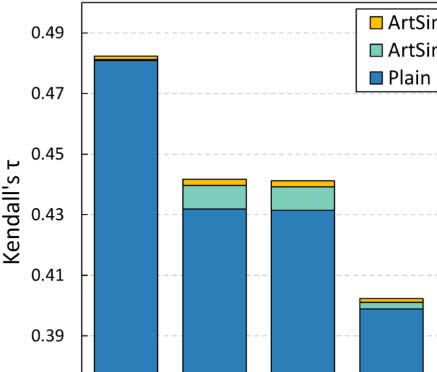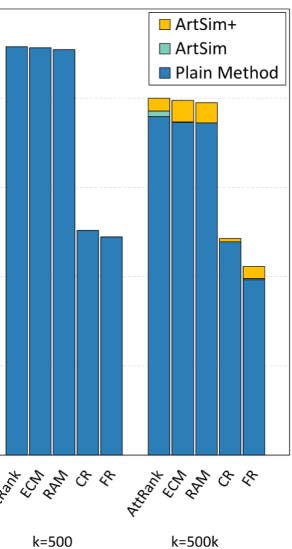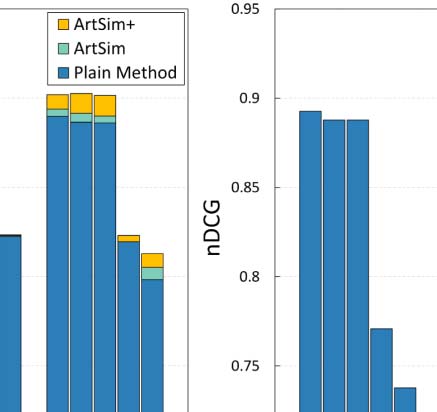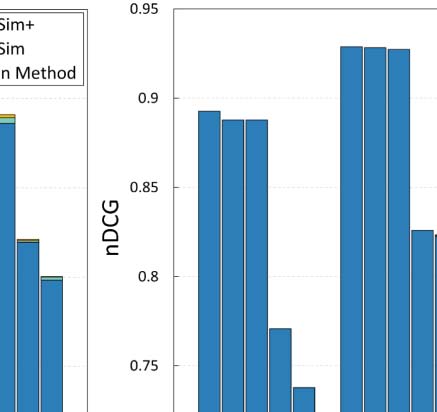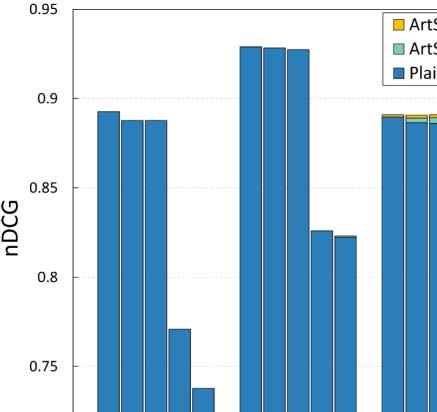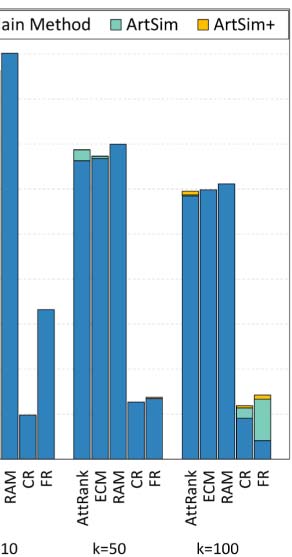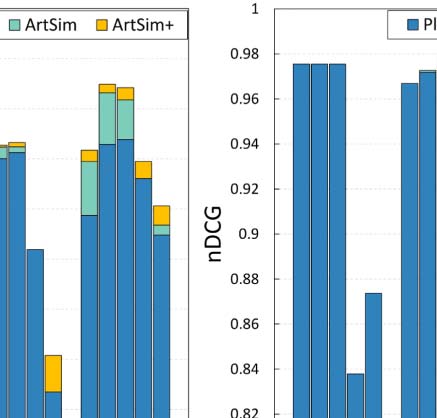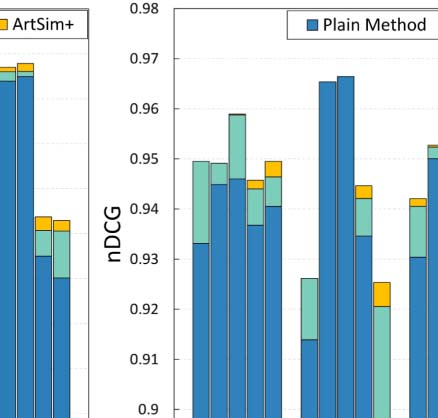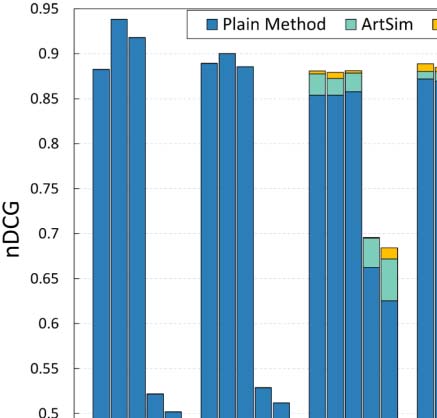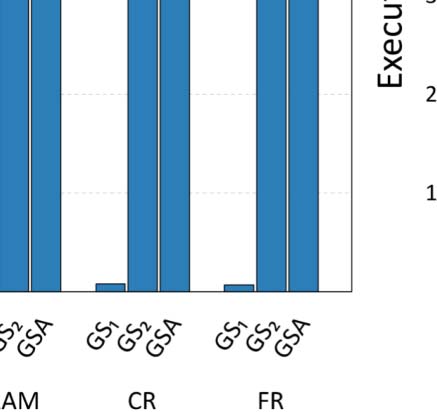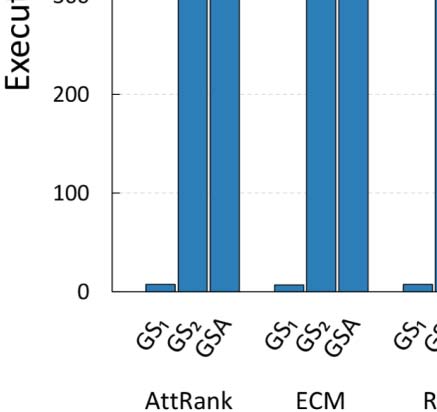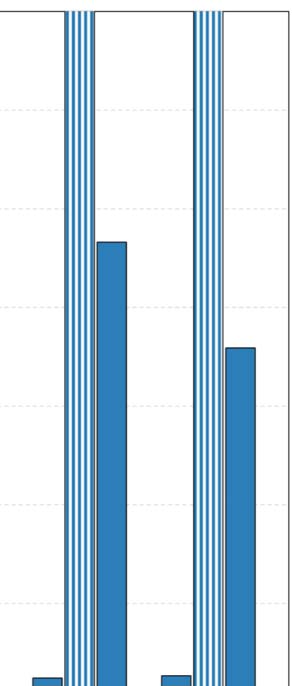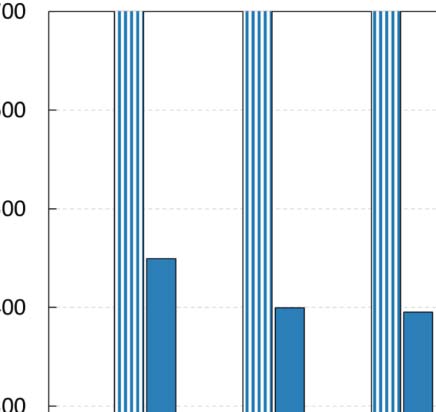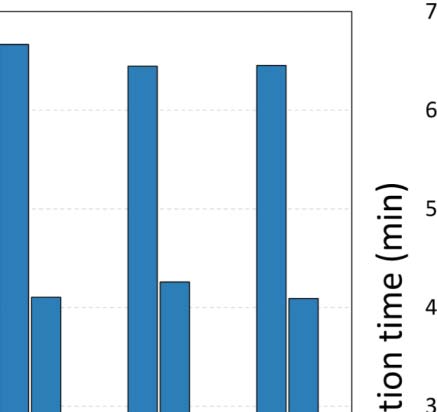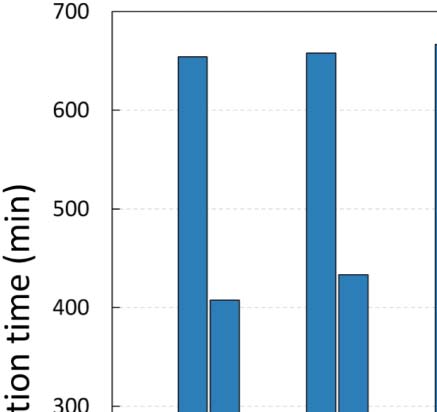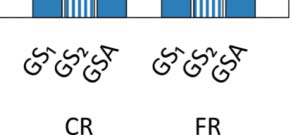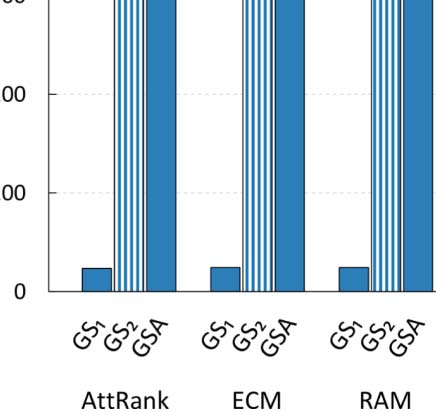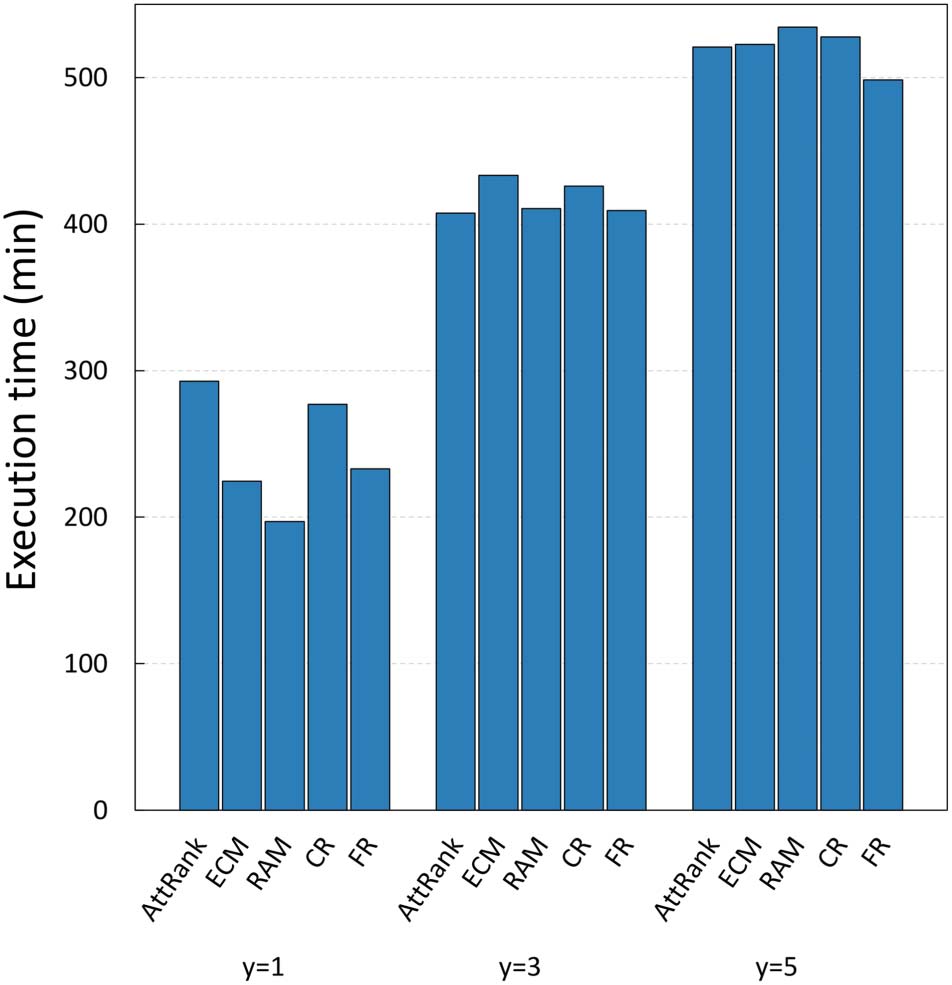RESEARCH ARTICLE
Further improvements on estimating the
popularity of recently published papers
Serafeim Chatzopoulos1,2
, Thanasis Vergoulis2
, Ilias Kanellos2
,
Theodore Dalamagas2
, and Christos Tryfonopoulos1
1Department of Informatics and Telecommunications, University of the Peloponnese, Tripolis, 希腊
2Information Management Systems Institute (IMSI), “Athena” Research Center, 雅典, 希腊
关键词: scientific impact assessment, scholarly knowledge graphs
抽象的
As the number of published scientific papers continually increases, the ability to assess their
impact becomes more valuable than ever. 在这项工作中, we focus on the problem of estimating
the expected citation-based popularity (or short-term impact) of papers. State-of-the-art
methods for this problem attempt to leverage the current citation data of each paper. 然而,
these methods are prone to inaccuracies for recently published papers, which have a limited
citation history. 在此背景下, we previously introduced ArtSim, an approach that can
be applied on top of any popularity estimation method to improve its accuracy. Its power
originates from providing more accurate estimations for the most recently published papers
by considering the popularity of similar, older ones. 在这项工作中, we present ArtSim+,
an improved ArtSim adaptation that considers an additional type of paper similarity and
incorporates a faster configuration procedure, resulting in improved effectiveness and
configuration efficiency.
我
D
哦
w
n
哦
A
d
e
d
F
r
哦
米
H
t
t
p
:
/
/
d
我
r
e
C
t
.
米
我
t
.
/
e
d
你
q
s
s
/
A
r
t
我
C
e
–
p
d
我
F
/
/
/
/
2
4
1
5
2
9
2
0
0
7
8
5
6
q
s
s
_
A
_
0
0
1
6
5
p
d
/
.
F
乙
y
G
你
e
s
t
t
哦
n
0
7
S
e
p
e
米
乙
e
r
2
0
2
3
1.
介绍
With the growth rate of scientific articles (also known as papers) continually increasing (Larsen
& von Ins, 2010), the reliable assessment of their scientific impact is now more valuable than
曾经. 最后, a variety of impact measures have been proposed, aiming to quantify
scientific impact at the paper level. Such measures have various practical applications:
例如, they can be used to rank the results of keyword-based searches (例如, Vergoulis,
Chatzopoulos et al., 2019), facilitating literature exploration and reading prioritization, 或者
assist the comparison and monitoring of the impact of different research projects, 机构,
or researchers (例如, Papastefanatos, Papadopoulou et al., 2020).
Because scientific impact can be defined in many, diverse ways (Bollen, Van de Sompel
等人。, 2009), the proposed measures vary in terms of the approach they follow (例如,
citation-based, altmetrics), as well as in the aspect of scientific impact they attempt to capture
(例如, impact in academia, social media attention). 在这项工作中, we focus on citation-based
measures that attempt to estimate the expected scientific impact of each paper in the near
未来 (IE。, its current popularity). Providing accurate estimations of paper popularity is an
open problem, as indicated by a recent extensive experimental evaluation (Kanellos, Vergoulis
等人。, 2021A). 此外, popularity distinctly differs from the overall (long-term) impact of a
paper that is usually captured by traditional citation-based measures (例如, citation count).
开放访问
杂志
引文: Chatzopoulos, S。, Vergoulis,
T。, Kanellos, 我。, Dalamagas, T。, &
Tryfonopoulos, C. (2021). 更远
improvements on estimating the
popularity of recently published
文件. Quantitative Science Studies,
2(4), 1529–1550. https://doi.org/10.1162
/qss_a_00165
DOI:
https://doi.org/10.1162/qss_a_00165
通讯作者:
Serafeim Chatzopoulos
schatzop@uop.gr
版权: © 2021 Serafeim
Chatzopoulos, Thanasis Vergoulis, Ilias
Kanellos, Theodore Dalamagas, 和
Christos Tryfonopoulos. 已发表
under a Creative Commons Attribution
4.0 国际的 (抄送 4.0) 执照.
麻省理工学院出版社
Further improvements on estimating the popularity of recently published papers
One important issue in estimating paper popularity is to provide accurate estimations for
the most recently published papers. The estimations of most popularity measures rely on the
existing citation history of each paper. 然而, as very limited citation history data are avail-
able for recent papers, their impact estimation based on these data is prone to inaccuracies.
因此, these measures fail to provide accurate estimations for recent papers. To alleviate this
问题, in Chatzopoulos, Vergoulis et al. (2020) we introduced ArtSim, an approach that can be
applied on top of any existing popularity estimation method to improve its accuracy. ArtSim
does not only rely on each paper’s citation history data but also considers the history of older,
similar papers, for which these data are more complete. The intuition behind the approach is that
similar papers (例如, having similar topics and/or author lists) are likely to have similar popularity
dynamics. To quantify paper similarity, ArtSim exploits author lists and the involved topics,
based on data that can be easily found in scholarly knowledge graphs, a large variety of which
has been made available in recent years (例如, AMiner’s DBLP-based data sets (唐, 张
等人。, 2008), the Open Research Knowledge Graph (Jaradeh, Oelen et al., 2019), the OpenAIRE
Research Graph (Manghi, Atzori et al., 2019A; Manghi, Bardi et al., 2019乙)).
Our experiments showed that ArtSim effectively enhances the performance of traditional
methods in estimating article popularity. 然而, 同时, we found that there was
room for further improvements. 在此背景下, we extended ArtSim and produced an
improved version called ArtSim+. This new approach maintains all the benefits of ArtSim
and introduces two main improvements: (A) it takes into consideration an additional type of
paper similarities, based on their publication venues, 和 (乙) it leverages a more efficient and
more effective configuration procedure based on the technique of generalized simulated
annealing. To evaluate ArtSim+’s performance, we reproduce the most important of our pre-
vious experiments and we extend them by investigating the effect on an additional popularity
estimation method. 此外, we conduct thorough experiments to showcase the effects of
the new configuration procedure. 最后, we provide both ArtSim and ArtSim+ implemen-
tations as open source code under a GNU/GPL license1.
2. 背景
2.1. Preliminaries
在这项工作中, we focus on approaches that aim at estimating the citation-based popularity of
scientific papers. 一般来说, citation-based measures are defined and calculated on top of the
citation network, 那是, the directed graph of all papers (节点) along with their citations
(边缘); each directed edge i → j, with i and j being nodes of the graph, denotes that paper
i cites paper j. This information is usually encoded in the citation network’s adjacency matrix
A, where A[我, j] = 1 if a paper j cites paper i and A[我, j] = 0, 否则.
For popularity, we adopt the definition given in Kanellos et al. (2021A). According to this,
popularity at current time tc can only be accurately quantified a posteriori, when papers
receive citations as a result of being currently studied. Because citation networks evolve over
时间, we define the adjacency matrix at time tc as A(tc). Given a parameter T, which denotes a
future time window, we can define adjacency matrix A(tc + 时间 ) − A(tc), which describes the
citation network containing only the citations made in the time span [tc, tc + 时间]. The popularity
of papers is then given by the citation count based on A(tc + 时间 ) − A(tc). It is worth mentioning
that T is a problem parameter, which depends on various factors, such as the publication life
cycle in a particular scientific discipline (manuscript writing, peer-review, 出版物).
1 https://github.com/schatzopoulos/ArtSim
Quantitative Science Studies
1530
我
D
哦
w
n
哦
A
d
e
d
F
r
哦
米
H
t
t
p
:
/
/
d
我
r
e
C
t
.
米
我
t
.
/
e
d
你
q
s
s
/
A
r
t
我
C
e
–
p
d
我
F
/
/
/
/
2
4
1
5
2
9
2
0
0
7
8
5
6
q
s
s
_
A
_
0
0
1
6
5
p
d
/
.
F
乙
y
G
你
e
s
t
t
哦
n
0
7
S
e
p
e
米
乙
e
r
2
0
2
3
Further improvements on estimating the popularity of recently published papers
数字 1. A scholarly knowledge graph including papers, authors, venues, and topics.
Our proposed approach to estimate popularity is based on exploiting path-based similarities of
papers that can be calculated using scholarly knowledge graphs. Knowledge graphs, also known
as heterogeneous information networks (Shi, 李等人。, 2017), are graphs that encode rich domain-
specific information about various types of entities, represented as nodes, and the relationships
它们之间, represented as edges. 数字 1 presents an example of such a knowledge graph,
consisting of nodes representing papers (磷), authors (A), venues (V), and topics (时间). Three types of
(bidirectional) edges are present in this example network: edges between authors and papers,
denoted as AP or PA, edges between papers and topics, denoted as PT or TP, and edges between
papers and venues, denoted as PVor VP. The first edge type captures the authorship of papers, 这
second one encodes the information that a particular paper is written on a particular topic, 尽管
the last one captures the fact that a paper has been published in a particular venue.
Various semantics are implicitly encoded in the paths (IE。, edge/node sequences) of knowl-
edge graphs. 实际上, all paths that correspond to the same sequence of node and edge types
(IE。, the same metapath (Sun, Han et al., 2011乙)) encode latent relationships of the same inter-
pretation between the starting and ending nodes. Metapaths can be represented by the
sequence of the respective node and edge types but, for the sake of simplifying the notation,
it is usually assumed (Shi, 李等人。, 2016A; 孙等人。, 2011乙) that there is at most one type of
edges between any pair of node types in the HIN, thus each metapath is denoted by the
sequence of the respective node types. 例如, in the graph of Figure 1, the metapath
作者 – 纸 – 话题 – 纸 – 作者, or APTPA for brevity, relates two authors that
have published works in the same topic (例如, both ‘John Doe’ and ‘Henry Jekyll’ have
papers about ‘DL’). Metapaths are useful for many graph analysis and exploration applica-
系统蒸发散. 例如, in our approach, we use them to calculate metapath-based similarities: 这
similarity between two nodes of the same type, based on the semantics of a given metapath,
can be captured by considering the number of instances of this metapath connecting these
节点 (例如, 孙等人。, 2011乙; Xiong, 朱, & 于, 2015).
2.2. 相关工作
2.2.1. Methods to estimate scientific impact
There is a lot of work in the areas of bibliometrics and scientometrics to quantify the impact of
scientific articles. Much focus was been on methods to calculate variations of the citation
Quantitative Science Studies
1531
我
D
哦
w
n
哦
A
d
e
d
F
r
哦
米
H
t
t
p
:
/
/
d
我
r
e
C
t
.
米
我
t
.
/
e
d
你
q
s
s
/
A
r
t
我
C
e
–
p
d
我
F
/
/
/
/
2
4
1
5
2
9
2
0
0
7
8
5
6
q
s
s
_
A
_
0
0
1
6
5
p
d
/
.
F
乙
y
G
你
e
s
t
t
哦
n
0
7
S
e
p
e
米
乙
e
r
2
0
2
3
Further improvements on estimating the popularity of recently published papers
counts and PageRank. The latter algorithm, although originally introduced to evaluate the
importance of Web pages, has been successfully adapted and applied to citation networks
providing insights about the scientific impact of papers (陈, Xie et al., 2007). 此外,
it has additionally spawned a separate line of work that aims at improving it when applied on
citation networks (Mariani, Medo, & 张, 2016; Su, Pan et al., 2011; Vaccario, Medo et al.,
2017; 周, Zheng et al., 2016). However these works focus on capturing the overall impact
of papers, instead of their expected short-term impact (or popularity) (戈什, Kuo et al., 2011;
Sayyadi & Getoor, 2009; 沃克, Xie et al., 2007). This is an interesting problem, as on the one
hand this problem has been shown to have a more pronounced improvement margin (Kanellos
等人。, 2021A), and on the other hand it corresponds to important real application scenarios:
Researchers using search engines to find papers in their scientific fields would benefit from a
popularity-based ranking to find the current and most recent research trends. In-depth exam-
inations of various impact measures that have been proposed in the relevant literature can be
found in Kanellos et al. (2021A) and Bai, 刘等人. (2017). In contrast to these methods, ArtSim
and ArtSim+, our approaches, do not aim to introduce a new popularity measure but rather aim
to improve the accuracy of existing ones.
2.2.2. ArtSim
在之前的工作中 (Chatzopoulos et al., 2020), we introduced ArtSim, an approach that can be
applied on top of any popularity estimation method to improve its accuracy. Its power origi-
nates from providing better estimations for most of the recently published papers by finding
older papers that are similar to them, and considering their average popularity. The intuition is
that older papers have a more complete citation track and that similar papers are likely to
follow a similar trajectory in terms of popularity. To quantify paper similarity, ArtSim exploits
the corresponding author lists and the involved topics. This information is available in schol-
arly knowledge graphs, a large variety of which have been made available in recent years.
2.2.3.
Entity similarity in HINs
Both ArtSim+ and its predecessor are built upon recent work on entity similarity in the area of
heterogeneous information networks. Some of the first entity similarity approaches for such
网络 (例如, PopRank (Nie, 张等人。, 2005) and ObjectRank (Balmin, Hristidis, &
Papakonstantinou, 2004)) are based on random walks. Later works, such as PathSim (Sun
等人。, 2011乙), focus on providing more meaningful results by calculating node similarity mea-
sures based on user-defined semantics. Our work is based on JoinSim (Xiong et al., 2015), 这是
more efficient compared to PathSim, making it more suitable for analyses on large-scale networks.
3. ARTSIM+
3.1. Basic Approach
Like its predecessor, ArtSim+ can be applied on top of any popularity measure to increase
the accuracy of its estimations. 像这样, ArtSim+ takes the scores calculated by any popu-
larity method as input, applies transformations on them, and produces a new set of improved
popularity scores. This process is illustrated in Figure 2.
The transformations applied on popularity scores by ArtSim+, rely on the assumption that
similar articles are expected to share similar popularity dynamics. To calculate the similarity
between different papers, ArtSim+ relies on a scholarly knowledge graph that contains infor-
mation about papers, authors, venues, and topics, as well as connections between them (喜欢
the one presented in Figure 1). On a knowledge graph of such a schema, it is possible to define
Quantitative Science Studies
1532
我
D
哦
w
n
哦
A
d
e
d
F
r
哦
米
H
t
t
p
:
/
/
d
我
r
e
C
t
.
米
我
t
.
/
e
d
你
q
s
s
/
A
r
t
我
C
e
–
p
d
我
F
/
/
/
/
2
4
1
5
2
9
2
0
0
7
8
5
6
q
s
s
_
A
_
0
0
1
6
5
p
d
.
/
F
乙
y
G
你
e
s
t
t
哦
n
0
7
S
e
p
e
米
乙
e
r
2
0
2
3
Further improvements on estimating the popularity of recently published papers
数字 2. Our proposed approach.
paper similarity according to various semantics using the JoinSim (Xiong et al., 2015) 相似
measure calculated on different metapaths (参见章节 2.1 欲了解详情). ArtSim+ considers
paper similarity according to the Paper – 作者 – 纸 (PAP), 纸 – 话题 –
纸 (PTP), and Paper – Venue – 纸 (PVP) metapaths. The PAP metapath defines
the similarity of papers according to their common authors, the PTP metapath defines similar-
ity based on their common topics, and the PVP metapath is based on their venue. ArtSim+
uses the calculated similarity scores to provide improved popularity estimates (scores),
focusing, 尤其, on recent papers that have a limited citation history (IE。, those that
are going through their cold start period ). The calculation of ArtSim+ scores is based on
the following formula:
(西德:1)
S pð Þ ¼
A (西德:2) SPAP pð Þ þ β (西德:2) SPTP pð Þ þ γ (西德:2) SPVP þ δ (西德:2) Si pð Þ; p:year > tc −y
Si pð Þ;
否则
where SPAP, SPTP, and SPVP are the average popularity scores of all the articles that are similar to
p, based on metapaths PAP, PTP, and PVP respectively. Si is the initial popularity score of
paper p based on the original popularity measure and tc denotes the current year. 最后,
our method applies transformations on popularity scores for those papers published in years
that range in the time span (tc − y, tc], where y > 0.
3.2.
Improving Method Configuration
ArtSim+ depends on parameters α, β, C, δ 2 [0, 1], the values of which are set so that α + β +
C + δ = 1. Varying these parameters in the range [0, 1] has the following effects: As α increases,
ArtSim+ score mostly depends on similar articles based on common authors. 相似地, as β
and γ increase, the score is mainly based on similar articles based on common topics and
venues, 分别. 最后, as δ approaches 1 the popularity scores remain identical to those
calculated by the original popularity measure.
To determine the best configuration of our approach, an exhaustive “grid” search of the
parameter space can be performed. The original version of ArtSim (Chatzopoulos et al.,
2020) follows this approach, but the same technique can be applied on any possible ArtSim
adaptation incorporating different types of metapaths. 然而, grid search can be highly
inefficient; 在实践中, the efficiency of such a search depends on the number of parameters
to be determined and the granularity of the examined grid. 因此, in the case of a method with
a large number of parameters (such as ArtSim+) the corresponding search grid could be
really large, resulting in a time-consuming process. To counterbalance this problem a
coarse-grained grid search could be performed. 然而, this would run the risk of missing
the optimal configuration.
Quantitative Science Studies
1533
我
D
哦
w
n
哦
A
d
e
d
F
r
哦
米
H
t
t
p
:
/
/
d
我
r
e
C
t
.
米
我
t
.
/
e
d
你
q
s
s
/
A
r
t
我
C
e
–
p
d
我
F
/
/
/
/
2
4
1
5
2
9
2
0
0
7
8
5
6
q
s
s
_
A
_
0
0
1
6
5
p
d
.
/
F
乙
y
G
你
e
s
t
t
哦
n
0
7
S
e
p
e
米
乙
e
r
2
0
2
3
Further improvements on estimating the popularity of recently published papers
To alleviate this issue, we propose the use of the Generalized Simulated Annealing (GSA) (Tsallis
& Stariolo, 1996; Xiang, 孙等人。, 1997) algorithm to search the parameter space for the optimal
configuration instead of performing a full grid search. GSA is a search algorithm that can be used to
approximate the optimal parameter values for an optimization problem (例如, to find the parame-
ters of ArtSim+ that achieve the best accuracy). It combines the approach of Simulated Annealing
(在) (柯克帕特里克, Gelatt, & Vecchi, 1983) with that of Fast Simulated Annealing (FSA) (Szu &
Hartley, 1987). SA is a traditional search algorithm that combines hill climbing with a random
search mechanism, accepting not only changes that improve the objective function but also
underperforming ones with a certain probability. 然而, SA employs a local visiting distribution
(Gaussian) so that the majority of the search is confined in certain regions of the search space. 为了
this reason, Fast Simulated Annealing (FSA) was introduced. FSA utilizes a semilocal distribution
(Cauchy-Lorentz) traversing the search space more efficiently, but it can still be trapped in local
optima (Xiang & 锣, 2000). GSA achieves faster convergence and higher probability to find the
global optimal (Xiang & 锣, 2000), outperforming SA and FSA. It utilizes a distorted Cauchy-
Lorentz distribution controlled by parameter qv, while its acceptance probability depends on the
acceptance parameter qα (Xiang, Gubian et al., 2013). GSA searches the space more uniformly
than its competitors, with the difference in performance being more prominent as the number
of variables of the objective function increases (Xiang & 锣, 2000).
我
D
哦
w
n
哦
A
d
e
d
F
r
哦
米
H
t
t
p
:
/
/
d
我
r
e
C
t
.
米
我
t
.
4. EVALUATION
在这个部分, we discuss the experiments conducted to assess the effectiveness of our
方法. 尤其, we first elaborate on the experimental setup (部分 4.1). 然后, 在
部分 4.2, we provide our findings regarding the effectiveness of ArtSim+ in improving
the accuracy of various state-of-the-art popularity estimation methods. During this experiment
we also compare ArtSim+ to ArtSim (Chatzopoulos et al., 2020), its predecessor, 展示-
casing the superior performance of the current approach. 最后, in Section 4.3 we discuss
the efficiency and effectiveness gains introduced to ArtSim+ due to the improved config-
uration process described in Section 3.2.
/
e
d
你
q
s
s
/
A
r
t
我
C
e
–
p
d
我
F
/
/
/
/
2
4
1
5
2
9
2
0
0
7
8
5
6
q
s
s
_
A
_
0
0
1
6
5
p
d
/
.
F
乙
y
G
你
e
s
t
t
哦
n
0
7
S
e
p
e
米
乙
e
r
2
0
2
3
4.1. 实验装置
4.1.1. Data sets
对于我们的实验, we used the following data sets:
(西德:129) DBLP Scholarly Knowledge Graph (DSKG) 数据集. This contains data for 3,079,008 com-
puter science papers, 1,766,548 authors, 5,079 venues and 3,294 topics from DBLP. 这是
based on AMiner’s citation network data set (Tang et al., 2008) enriched with topics from the
CSO Ontology (Salatino, Thanapalasingam et al., 2018). The topics have been assigned to
each paper by applying the CSO Classifier (Salatino, Osborne et al., 2019) to its abstract.
(西德:129) DBLP Article Similarities (DBLP-ArtSim) 数据集. This contains similarities among papers in
the previous network based on different metapaths. 尤其, we calculated paper sim-
ilarities based on (A) their author list using the Paper – 作者 – 纸 (PAP) metapath,
(乙) their common topics, captured by the Paper – 话题 – 纸 (PTP) metapath, 和
(C) their venue, according to the Paper – Venue – 纸 (PVP) metapath2. This data set
is openly available on Zenodo3 (Chatzopoulos, Vergoulis et al., 2021) under CC BY 4.0
2 For PAP and PTP all paper pairs with similarities less than 0.2 were dropped; for PVP all pairs with zero
similarity were dropped.
3 https://doi.org/10.5281/zenodo.3778915
Quantitative Science Studies
1534
Further improvements on estimating the popularity of recently published papers
license and contains approximately 31 million PAP, 207 million PTP, 和 11 billion PVP
metapath instances. It should be noted that the first version of this data set was a contri-
bution of our previous work (Chatzopoulos et al., 2020); the current version of the data set
has been updated to also include the Paper to Venue relationships.
4.1.2.
Evaluation methodology
To assess the accuracy of methods in estimating paper popularity, we follow the experimental
framework proposed in Kanellos et al. (2021A). As discussed in Sections 1 和 2, a paper’s pop-
独特性, by definition, is reflected in the citations it receives in the near future. The aforementioned
framework splits a given citation network data set C into two parts, Cold and Cfuture, 根据一个
given split time point ts and uses Cold (containing all papers published no later than ts) as input to
the estimation methods, while Cfuture (all papers published between ts and a second given time
point ts + 时间, with T > 0) is taken as a ground truth. The ground truth is used to calculate, for each
paper published no later than ts, all citations it received during the (ts, ts + 时间 ] 时期. 然后, the total
orderings (the rankings) of these papers based on these citations are compared with the rankings
provided by each popularity estimation method. The method that produced the most similar
ranking to the ground truth ranking is the one with the most accurate estimations. The ranking
similarities are usually measured using both an overall similarity measure (例如, the ranked list
correlation according to Spearman’s ρ or Kendall’s τ), and a top-k similarity measure (例如,
nDCG@k); each type of similarity better fits the need of different applications.
At this point, it should be highlighted that each popularity estimation method produces its own
measure value for each paper (IE。, its own score), and thus a direct comparison of these scores for
the same paper is not possible; 所以, comparing the similarities of the methods’ ranking to the
ground truth ranking to measure each method’s accuracy is an adequate alternative, 特别是作为
most applications only require popularity/impact measures for partial comparisons.
In our experiments, we configured the framework so that ts splits the used citation network
data set into two equally sized (in terms of nodes) 网络, while T is selected so that Cfuture
包含 30% more papers than Cold. Regarding ranked list similarities, we use Kendall’s τ
(肯德尔, 1948) to capture their overall similarity, while we use nDCG@k to capture their
top-k similarity. Kendall’s τ is an overall correlation measure, having values in the [−1, 1]
范围, 和 1 and −1 corresponding to a perfect agreement and disagreement, 分别,
尽管 0 reflects no correlation. nDCG@k, 另一方面, is a measure of ranking quality
that has values in the range [0, 1], 和 1 corresponding to ideal ranking of the top-k elements.
4.1.3. Popularity estimation methods
As mentioned, our approaches (ArtSim and ArtSim+) are used on top of other popularity
estimation methods, resulting in improvements in their estimation accuracy. 因此, any exper-
iments should involve at least one popularity method, on top of which ArtSim and ArtSim+
will be applied. 在这项工作中, we selected to use four popularity estimation methods that were
found to perform well according to a recent experimental study (Kanellos et al., 2021A). 在
添加, we have also included AttRank (Kanellos, Vergoulis et al., 2021乙), which was found
to outperform the best popularity estimation methods in later experiments. 然而, this is just
an indicative set of methods: ArtSim and ArtSim+ can be easily applied on top of any other
一. The configurations used for each method (presented in Tables 1 和 2) 已经
selected after examining various configurations and selecting the one that achieved the best
result according to the similarity measure (Kendall’s τ or nDCG@k, see also Section 4.1.2)
under consideration.
Quantitative Science Studies
1535
我
D
哦
w
n
哦
A
d
e
d
F
r
哦
米
H
t
t
p
:
/
/
d
我
r
e
C
t
.
米
我
t
.
/
e
d
你
q
s
s
/
A
r
t
我
C
e
–
p
d
我
F
/
/
/
/
2
4
1
5
2
9
2
0
0
7
8
5
6
q
s
s
_
A
_
0
0
1
6
5
p
d
/
.
F
乙
y
G
你
e
s
t
t
哦
n
0
7
S
e
p
e
米
乙
e
r
2
0
2
3
Further improvements on estimating the popularity of recently published papers
桌子 1.
Parameter configuration for each popularity measure for Kendall’s τ
方法
AttRank
ECM
RAM
CR
FR
Configuration
α = 0.2, β = 0.4, γ = 0.4, y = 3
α = 0.2, γ = 0.4
γ = 0.4
α = 0.4, τdir = 10
α = 0.5, β = 0.2, γ = 0.3, ρ = −0.42
而且, for convenience, we briefly describe the intuition behind each method below:
(西德:129) AttRank (Kanellos et al., 2021乙) is a PageRank variation that modifies PageRank’s so-
called random jump probability. In AttRank, this probability is not uniform, but results
as a combination of an age-based weight, and a recent attention-based weight. The latter
is determined based on the fraction of total citations received by each paper in recent
年. It uses parameters α, β, C 2 (0, 1), ρ 2 (−∞, 0), 和y. Parameter y denotes the
starting year, onward from which the recent attention is determined. Parameter ρ is
the coefficient of the publication age-based weights, which decrease exponentially
based on age. Parameters α, β, γ are the coefficients of the PageRank calculation, ran-
dom jump probability based on recent attention, and random jump probability based on
publication age, 分别.
(西德:129) Retained Adjacency Matrix (RAM ) (Ghosh et al., 2011) estimates popularity using a time-
aware adjacency matrix to capture the recency of cited papers. The parameter γ 2 (0, 1)
is used as the basis of an exponential function to scale down the value of a citation link
according to its age.
(西德:129) Effective Contagion Matrix (ECM ) (Ghosh et al., 2011) is an extension of RAM that also
considers the temporal order of citation chains apart from direct links. It uses two param-
eters α, C 2 (0, 1) where α is used to adjust the weight of citation chains based on their
length and γ is the same as in RAM.
(西德:129) CiteRank (CR) (Walker et al., 2007) estimates popularity by simulating the behavior of
researchers searching for new articles. It uses two parameters, A 2 (0, 1) and τdir 2 (0, ∞)
to model the traffic to a given paper. A paper is randomly selected with an exponentially
discounted probability according to its age with τdir being the decay factor. Parameter α
数字 3. Effectiveness of our approach (Kendall’s τ) for each popularity method.
Quantitative Science Studies
1536
我
D
哦
w
n
哦
A
d
e
d
F
r
哦
米
H
t
t
p
:
/
/
d
我
r
e
C
t
.
米
我
t
.
/
e
d
你
q
s
s
/
A
r
t
我
C
e
–
p
d
我
F
/
/
/
/
2
4
1
5
2
9
2
0
0
7
8
5
6
q
s
s
_
A
_
0
0
1
6
5
p
d
/
.
F
乙
y
G
你
e
s
t
t
哦
n
0
7
S
e
p
e
米
乙
e
r
2
0
2
3
Further improvements on estimating the popularity of recently published papers
is the probability that a researcher stops her search, 和 1 − α being the probability that
she continues with a reference of the paper she just read.
(西德:129) FutureRank (FR) (Sayyadi & Getoor, 2009) scores are calculated by combining PageRank
with calculations on a bipartite graph with authors and papers, while also promoting
recently published articles with time-based weights. It uses parameters α, β, C 2 (0, 1)
and ρ 2 (−∞, 0); α is the coefficient of the PageRank scores, β is the coefficient of the
authorship scores and γ is the coefficient of time-based weights which decrease expo-
nentially based on the exponent ρ.
4.2. Evaluating the Effectiveness of ArtSim+
In this experiment, we examine the gains introduced by applying ArtSim+ on top of various
popularity estimation methods in terms of their improved estimation accuracy. Based on the
evaluation framework used (参见章节 4.1.2), we first evaluate the estimation accuracy in
terms of Kendall’s τ (部分 4.2.1) and then in terms of nDCG@k (部分 4.2.2).
4.2.1.
Improvements in terms of Kendall’s τ
In this experiment, we examine the accuracy of each of the examined popularity estimation
方法 (AttRank, ECM, RAM, CR, and FR) with and without the assistance of ArtSim and
ArtSim+, in terms of Kendall’s τ, for y 2 {1, 3, 5}. Recall that y is the parameter that deter-
mines which papers are in their “cold start” phase (例如, if y = 3, then all papers published
between ts − 2 and ts are considered to be in their cold start phase). All methods were con-
figured based on the parameter settings included in Table 1, ArtSim was configured exactly
as it was in Chatzopoulos et al. (2020), and ArtSim+ was configured based on the outputs of
the experiments in Section 4.3. 数字 3 summarizes our findings.
全面的, both ArtSim and ArtSim+ introduce accuracy improvements to all popularity
estimation methods. In all cases, ArtSim+ achieves a larger improvement than ArtSim,
something that indicates that considering the venue-based paper similarities (captured by
the PVP metapath) indeed results in improving accuracy. The most significant improvements,
for both ArtSim and ArtSim+, are observed when they are applied on ECM and RAM. 在
特别的, ECM and RAM are improved by 10–12% when applying ArtSim+ over the plain
methods and by 4–5% over ArtSim for y 2 {3, 5}. AttRank, 另一方面, appears to have
significantly smaller gains. The larger gains achieved for RAM and ECM can be explained by
the fact that these methods rely heavily on each paper’s current citations. 因此, a large num-
ber of recent papers without any citations, 哪个, 然而, are likely to gather citations in the
near future, are ranked at the bottom based on these methods. 相比之下, AttRank, CR, and FR
give ranking advantages to papers based on their publication age. Hence the papers that can
benefit from ArtSim/ArtSim+ are already advantaged in part by these methods. It should be
noted that, as expected, smaller gains for all methods are achieved for y = 1. In that case, 作为
previously mentioned, our approach affects the popularity score of the papers published only
in the last year, affecting only a small fraction of the overall papers.
4.2.2.
Improvements in terms of nDCG@k
We also examine the accuracy of all estimation methods (with and without the ArtSim/
ArtSim+ assistance) in terms of nDCG@k, for y 2 {1, 3, 5} and k 2 {5, 50, 500 000}. 相似地
to the experiment in Section 4.2.1, the best configurations for the examined accuracy measure4
4 It should be noted that the corresponding experiments in Chatzopoulos et al. (2020) were conducted using
the best configurations according to Kendall’s τ (IE。, the popularity estimation methods had not been opti-
mized for the nDCG@k experiment).
Quantitative Science Studies
1537
我
D
哦
w
n
哦
A
d
e
d
F
r
哦
米
H
t
t
p
:
/
/
d
我
r
e
C
t
.
米
我
t
.
/
e
d
你
q
s
s
/
A
r
t
我
C
e
–
p
d
我
F
/
/
/
/
2
4
1
5
2
9
2
0
0
7
8
5
6
q
s
s
_
A
_
0
0
1
6
5
p
d
.
/
F
乙
y
G
你
e
s
t
t
哦
n
0
7
S
e
p
e
米
乙
e
r
2
0
2
3
Further improvements on estimating the popularity of recently published papers
方法
AttRank
ECM
RAM
CR
FR
桌子 2.
Parameter configuration for each popularity estimation measure for nDCG@k
k = 5
α = 0.2, β = 0.8, γ = 0, y = 1
k = 500
α = 0.2, β = 0.8, γ = 0, y = 1
k = 500,000
α = 0, β = 0.7, γ = 0.3, y = 1
α = 0.3, γ = 0.1
γ = 0.1
α = 0.1, τdir = 1
α = 0.3, γ = 0.1
γ = 0.1
α = 0.2, τdir = 1
α = 1, γ = 0.3
γ = 0.3
α = 0.4, τdir = 0.8
α = 0.1, β = 0, γ = 0.9, ρ = −0.82
α = 1, β = 0, γ = 0.9, ρ = −0.62
α = 0.5, β = 0.1, γ = 0.4, ρ = −0.42
were selected for ArtSim, ArtSim+, and each estimation method (see also Table 2). Our find-
ings are depicted in Figure 4.
有趣的是, for small values of k, our approach performs equally well as the plain popu-
larity estimation methods. This behavior indicates that, at least to some extent, 现有的
state-of-the-art methods accurately identify the top popular papers. Another apparent explana-
tion is that, in the case of a small k the set of top-k popular papers at the level of the whole data
放, mainly consists of widely known, fundamental papers that already have a significant
citation trajectory. To put it differently, the percentage of the top-k popular papers that are
going through their cold start period is significantly smaller for small k values (见表 3).
This characteristic of the small k values was the motivation to also examine the k = 500,000
价值, apart from k = 5 and k = 500. Going back to our experimental results, it is evident
that the accuracy gains for all popularity estimation methods are indeed more apparent for
k = 500,000.
It may be tempting to think that, although ArtSim+ brings evident accuracy improvements
in terms of Kendall’s τ, it can provide apparent improvements in terms of nDCG@k only for
extremely large k values, which are not relevant to any practical scenario. Although this seems
to be intuitively correct, this rationale does not reflect the truth, 因为, 在实践中, the over-
all top-ranking papers may be dominated by particular subfields that are characterized by a
higher citation density, or which gather citations quicker (例如, due to large numbers of fre-
quent conferences in the field). 因此, the accuracy gains that ArtSim+ brings may be useful
in various real applications involving searches on particular subfields/keywords. To showcase
这, we also conducted an experiment that replicates a real-world application scenario, that of
literature exploration by a researcher in an academic search engine.
The concept is the following: the users of such search engines usually refine their searches
based on multiple keywords and filters (例如, based on the venues of interest or the publication
年) to reduce the number of papers they have to examine. 然而, even in this case, usu-
ally at least hundreds of papers are contained in the results. 因此, effective popularity-based
ranking is crucial to facilitate the reading prioritization. Our experiment involves three indi-
vidual search scenarios. In the first scenario we used the query “expert finding.” This keyword
search resulted in a set of 549 文章. 数字 5(A) presents the nDCG values for this search, 每
popularity estimation method5, along with the gains of ArtSim and ArtSim+ for y = 3. 我们
5 All popularity estimation methods have been configured based on their parameters that achieve the best
nDCG@k values with k = 500,000 for the whole data set.
Quantitative Science Studies
1538
我
D
哦
w
n
哦
A
d
e
d
F
r
哦
米
H
t
t
p
:
/
/
d
我
r
e
C
t
.
米
我
t
.
/
e
d
你
q
s
s
/
A
r
t
我
C
e
–
p
d
我
F
/
/
/
/
2
4
1
5
2
9
2
0
0
7
8
5
6
q
s
s
_
A
_
0
0
1
6
5
p
d
/
.
F
乙
y
G
你
e
s
t
t
哦
n
0
7
S
e
p
e
米
乙
e
r
2
0
2
3
Further improvements on estimating the popularity of recently published papers
数字 4. Effectiveness of our approach (nDCG@k) for each popularity estimation method.
observe that ArtSim+ improves the nDCG values for k = 50 and k = 100. In our second sce-
成员, we tried a constrained query. 尤其, we used “recommender systems” as the
search keywords keeping only papers published in well-known venues of data management
and recommender systems, namely VLDB, SIGMOD, TKDE, ICDE, EDBT, RecSym, and ICDM.
The result set includes 318 文章. 数字 5(乙) presents the nDCG results. We observe that
ArtSim+ boosts nDCG scores for all measures, starting from the smallest value of k = 5.
最后, we tried a keyword search with the phrase “digital libraries” that yielded 3,793 文章;
the results are presented in Figure 5(C). 在这种情况下, the benefits are smaller than in the previous
two search scenarios; 然而, we do note that ArtSim and ArtSim+ add improvements to
the nDCG scores at k = 50 and k = 100.
全面的, the results of these keyword search scenarios indicate that in addition to improving
the overall correlation, our approach also offers improvements in the case of practical,
keyword-search based queries with regard to the top returned results. For all the aforemen-
tioned scenarios, the best parameter configuration of ArtSim and ArtSim+ are presented
in Table A3 of the Appendix.
4.3. ArtSim+ Configuration
ArtSim+ has a wide range of configuration parameters. This is why a new, GSA-based config-
uration process was introduced to easily and efficiently configure most of them (参见章节 3.2).
在这个部分, we present a series of experiments that evaluates the efficiency and accuracy
gains introduced by this process.
Before proceeding with the experiments, it is worth mentioning that ArtSim+ has a parameter
y, the values of which are manually selected. The reason for not including y in the automatic
桌子 3. Number of articles in cold start period in top-k most popular
k = 5
k = 500
k = 500,000
y = 1
0
2
9,701
y = 3
1
60
154,140
y = 5
1
129
262,454
1539
Quantitative Science Studies
我
D
哦
w
n
哦
A
d
e
d
F
r
哦
米
H
t
t
p
:
/
/
d
我
r
e
C
t
.
米
我
t
.
/
e
d
你
q
s
s
/
A
r
t
我
C
e
–
p
d
我
F
/
/
/
/
2
4
1
5
2
9
2
0
0
7
8
5
6
q
s
s
_
A
_
0
0
1
6
5
p
d
/
.
F
乙
y
G
你
e
s
t
t
哦
n
0
7
S
e
p
e
米
乙
e
r
2
0
2
3
Further improvements on estimating the popularity of recently published papers
数字 5. Effectiveness of our approach (nDCG@k) for various keyword search scenarios ( y = 3, varying k).
configuration process is that it gets discrete integer values from a narrow domain, and thus it is
easy to configured manually. 尤其, y is the parameter that determines which are the
papers that are going through their “cold start” phase. The best y value for a given data set relies
on the disciplines of the papers contained in it. 例如, papers from life sciences are
expected to receive citations at a faster rate than papers from theoretical mathematics; 因此,
a smaller y value should be selected to configure ArtSim+ for a data set with papers from the
former discipline than for another with papers from the latter one. The data set we are using for
our experiments contains computer science papers; based on previous experience, we decided
to use (for all of our experiments) y values that are not greater than 5. 尤其, we examined
three different configurations of this parameter (即, y = 1, y = 3, and y = 5) to investigate the
effect that different values of y have on the popularity estimation accuracy and to the gains intro-
duced by ArtSim+.
所以, the GSA-based automatic configuration process (here denoted as GSA) 是
focused on finding the best values for ArtSim+’s α, β, C, and δ. In our experiment, we used
GSA6 to find the best configuration of ArtSim+ in terms of accuracy (Kendall’s τ) for y = 3.
We also used two alternative configuration processes: A (满的) grid search that examines all
distinct α, β, C, δ values in [0, 1] with a step of size 0.1 (GS1) and a grid search using a step
of size 0.01 (GS2). 此外, because ArtSim can also be configured in a similar way
(然而, having only three instead of four parameters), we included it in the experiment,
还有. The execution times for all configuration approaches are depicted in Figure 6, 尽管
the achieved accuracy of each revealed configuration is presented in Table 4 (best accuracy
highlighted in bold).
First of all, it is apparent from Table 4 那, in almost all cases, GS2 and GSA identify con-
figurations that result in improved accuracy, compared to the best configuration identified by
GS1. 当然, the main benefit of the latter configuration processes is that it is significantly
faster than the other two, having the shortcoming of not finding the optimal configuration.
Although GS2 can identify configurations that achieve improved accuracy, the computational
cost of a full search in such a grid is very large. 尤其, in the case of ArtSim, GS2 was
found to be 35–40% slower than GSA, while in the case of ArtSim+ (which has one extra
6 For all our experiments, we used the implementation of GSA in SciPy9 assuming Kendall’s τ or nDCG@k as
我们的目标函数, setting qv = 2.62, qα = −5, and initial temperature T0 = 5,230.
Quantitative Science Studies
1540
我
D
哦
w
n
哦
A
d
e
d
F
r
哦
米
H
t
t
p
:
/
/
d
我
r
e
C
t
.
米
我
t
.
/
e
d
你
q
s
s
/
A
r
t
我
C
e
–
p
d
我
F
/
/
/
/
2
4
1
5
2
9
2
0
0
7
8
5
6
q
s
s
_
A
_
0
0
1
6
5
p
d
.
/
F
乙
y
G
你
e
s
t
t
哦
n
0
7
S
e
p
e
米
乙
e
r
2
0
2
3
Further improvements on estimating the popularity of recently published papers
数字 6. Execution times for different ArtSim/ArtSim+ configuration methods ( y = 3).
parameter that needs to be tuned) GS2 was so large that it did not finish execution after 5,000
minutes, with GSA finishing in less than 500 minutes.
As an additional remark, our experiments reveal that considering the venue-based paper
相似 (IE。, exploiting the PV-P metapath) is a valid addition to our approach. The first clue
to this is based on the fact that ArtSim+ outperforms ArtSim (见表 4); a second clue is
that for most of our experiments (presented in both the current and the previous section) 这
best ArtSim+ accuracy was achieved using a configuration for which γ > α, β (see Tables A1
and A2 of the Appendix).
As a final experiment, we investigated the effect of different values of parameter y in the
efficiency of the GSA configuration process for ArtSim+. The results are presented in
数字 7. It is apparent that an increase in the value of y results in larger configuration times.
This is due to the fact that as parameter y increases, the number of papers that are going
through their cold start period increases; thus ArtSim+ needs to perform calculations for more
文件.
桌子 4.
the best configuration ( y = 3)
ArtSim/ArtSim+’s accuracy (in terms of Kendall’s τ) for the examined methods, 使用
AttRank
ECM
RAM
CR
FR
GS1
0.4814
0.4661
0.4653
0.4011
0.3793
ArtSim
GS2
0.4814
0.4664
0.4656
0.4012
0.3794
GSA
0.4814
0.4664
0.4656
0.4012
0.3794
ArtSim+
GS2
–
–
–
–
–
GS1
0.4880
0.4832
0.4823
0.4093
0.3917
GSA
0.4883
0.4837
0.4827
0.4094
0.3919
1541
Quantitative Science Studies
我
D
哦
w
n
哦
A
d
e
d
F
r
哦
米
H
t
t
p
:
/
/
d
我
r
e
C
t
.
米
我
t
.
/
e
d
你
q
s
s
/
A
r
t
我
C
e
–
p
d
我
F
/
/
/
/
2
4
1
5
2
9
2
0
0
7
8
5
6
q
s
s
_
A
_
0
0
1
6
5
p
d
.
/
F
乙
y
G
你
e
s
t
t
哦
n
0
7
S
e
p
e
米
乙
e
r
2
0
2
3
Further improvements on estimating the popularity of recently published papers
数字 7. GSA execution times for ArtSim+ configuration for different y values.
4.4. 讨论
Previous sections outlined the improvements in estimation accuracy that ArtSim+ introduces
when applied on top of existing popularity estimation methods in terms of Kendall’s τ and
nDCG@k. Despite the fact that ArtSim+ exhibits gains in estimation accuracy in all consid-
ered popularity estimation methods, in the configuration we examined, we make some partic-
ular limiting assumptions.
First of all, as already mentioned, the impact of papers has multiple aspects; some of them
may be captured (to an extent) by particular types of citation analysis, others can only be quan-
tified by altmetrics, while there are also aspects that are very difficult to quantify. ArtSim+
focuses on estimating citation-based short-term impact, which is more formally described in
部分 2.1, hence it is not examined whether it is useful in estimating other scientific impact
aspects. It is also really important to mention that, although related, impact and scientific merit
are not completely (or even highly) correlated.
而且, ArtSim+ considers similarity between papers based on three specific dimen-
西翁 (IE。, authors, topics and publication venues captured by metapaths PAP, PTP, 和
PVP respectively). 当然, the choice of the actual metapaths is not an inherent limitation
of ArtSim+ as it can be adapted accordingly to also incorporate other metapaths. 然而, 它
is important to highlight that the currently tested version of ArtSim+ makes the aforemen-
tioned assumption regarding paper similarity. An additional limitation with regard to the meta-
paths we chose to implement is that they are unconstrained, 那是, they do not limit the paths
to be considered according to the values of the attributes of the involved nodes or edges. 骗局-
strained metapaths (例如, used in Shi et al. (2016A)) could be used to tighten the focus of the
similarities to be considered. 例如, for a recent paper, it may be useful to consider its
相似, based on metapath PAP, but only to papers published in the last 10 年, as intu-
itively, a paper in its cold start period is more likely to share similar popularity dynamics with
the recent papers of a given author than with its older ones.
Quantitative Science Studies
1542
我
D
哦
w
n
哦
A
d
e
d
F
r
哦
米
H
t
t
p
:
/
/
d
我
r
e
C
t
.
米
我
t
.
/
e
d
你
q
s
s
/
A
r
t
我
C
e
–
p
d
我
F
/
/
/
/
2
4
1
5
2
9
2
0
0
7
8
5
6
q
s
s
_
A
_
0
0
1
6
5
p
d
.
/
F
乙
y
G
你
e
s
t
t
哦
n
0
7
S
e
p
e
米
乙
e
r
2
0
2
3
Further improvements on estimating the popularity of recently published papers
此外, the scholarly knowledge graph that ArtSim+ utilizes is based on AMiner’s
citation network data set (Tang et al., 2008) (参见章节 4.1.1 欲了解详情). Although this is a
popular data source used by many works (例如, Dong, Chawla, & Swami, 2017; Shi, 李等人。,
2016乙; Sun, Barber et al., 2011A), it comprises a limited number of node types. 知识
graphs with a richer schema, such as the Open Research Knowledge Graph (Jaradeh et al.,
2019) and the OpenAIRE Research Graph (Manghi et al., 2019A, 2019乙), would allow additional,
more complex metapaths to be used when considering paper similarity. 此外, contrary to
AMiner’s graph, which focuses on computer science papers (because it is based on papers
included in DBLP), the aforementioned knowledge graphs incorporate publications from various
学科, paving the way for the investigation of domains with possibly distinct characteristics.
In these cases, the importance of the examined similarity dimensions may be different, while even
选择, nonexamined dimensions may be of large importance.
最后但并非最不重要的, for recently published papers, ArtSim+ assigns the average of the pop-
ularity scores of their similar papers. Although using the average as an aggregation function is a
logical choice, other options can be examined as a future work, especially considering that the
popularity scores follow a power law distribution. It can also be useful to consider a weighted
scheme that incorporates the similarity score between papers in the aggregation process, 作为一个
paper may have significantly higher similarity scores with some papers than with others.
5. 结论
在这项工作中, we presented ArtSim+, an approach that can be applied on top of an existing
popularity estimation method to increase the accuracy of its results. The main intuition of our
approach is that the popularity of papers in their cold start period can be better estimated
based on the characteristics of older, similar papers. 为了我们的目的, paper similarity is cal-
culated exploiting information stored in scholarly knowledge graphs. More particularly, 这
proposed approach considers similarities based on the authors, the venues, and the topics
of the papers under consideration. Our experimental evaluation showcases the effectiveness
of ArtSim+, yielding noteworthy improvements in terms of Kendall’s τ correlation and nDCG
when applied on five state-of-the-art popularity measures, also outperforming ArtSim, its pre-
decessor, which had been introduced in Chatzopoulos et al. (2020).
Future work could address ArtSim+’s current limitations, or apply its underlying ideas in
different contexts (参见章节 4.4). 例如, it may be interesting to examine different
types of (更复杂) metapaths on HINs to calculate paper similarity. This could in turn
reveal new semantics on what constitutes “more similar” 文件, based on the underlying
metapaths. 而且, although ArtSim+ focuses on improving the estimation of paper pop-
ularity for cold start papers, similarity based on HINs could be used to improve the estimation
of different types of paper impact, such as long-term impact or social media attention.
致谢
数字 1 was designed using resources from www.flaticon.com.
作者贡献
Serafeim Chatzopoulos: 概念化, 数据管理, 方法, 软件, 验证,
Writing—original draft, Writing—review & 编辑. Thanasis Vergoulis: 概念化, Pro-
ject administration, 方法, 验证, Writing—original draft, Writing—review & 编辑.
Quantitative Science Studies
1543
我
D
哦
w
n
哦
A
d
e
d
F
r
哦
米
H
t
t
p
:
/
/
d
我
r
e
C
t
.
米
我
t
.
/
e
d
你
q
s
s
/
A
r
t
我
C
e
–
p
d
我
F
/
/
/
/
2
4
1
5
2
9
2
0
0
7
8
5
6
q
s
s
_
A
_
0
0
1
6
5
p
d
.
/
F
乙
y
G
你
e
s
t
t
哦
n
0
7
S
e
p
e
米
乙
e
r
2
0
2
3
Further improvements on estimating the popularity of recently published papers
Ilias Kanellos: 概念化, 数据管理, Writing—original draft, Writing—review &
编辑. Theodore Dalamagas: 监督, Writing—original draft, Writing—review & 编辑.
Christos Tryfonopoulos: 监督, Writing—original draft, Writing—review & 编辑.
COMPETING INTERESTS
The authors have no competing interests.
资金信息
We acknowledge support of this work by the project “Moving from Big Data Management to
Data Science” (MIS 5002437/3) which is implemented under the Action “Re-inforcement of
the Research and Innovation Infrastructure,” funded by the Operational Programme “Compet-
itiveness, Entrepreneurship and Innovation” (NSRF 2014-2020) and cofinanced by Greece and
欧盟 (European Regional Development Fund).
DATA AVAILABILITY
Article similarities used in our experimental evaluation are openly available on Zenodo (https://
doi.org/10.5281/zenodo.3778915) under CC BY 4.0 执照.
参考
Bai, X。, 刘, H。, 张, F。, Ning, Z。, 孔, X。, … Xia, F. (2017). 一个
overview on evaluating and predicting scholarly article impact.
信息, 8(3), 73. https://doi.org/10.3390/info8030073
Balmin, A。, Hristidis, 五、, & Papakonstantinou, 是. (2004). Objec-
trank: Authority-based keyword search in databases. 会议记录
of the 30th International Conference on Very Large Data Bases.
https://doi.org/10.1016/B978-012088469-8/50051-6
Bollen, J。, Van de Sompel, H。, Hagberg, A。, & Chute, 右. (2009). A
principal component analysis of 39 scientific impact measures.
PLOS ONE, 4(6), e6022. https://doi.org/10.1371/journal.pone
.0006022, 考研: 19562078
Chatzopoulos, S。, Vergoulis, T。, Kanellos, 我。, Dalamagas, T。, &
Tryfonopoulos, C. (2020). Artsim: Improved estimation of current
impact for recent articles. ADBIS, TPDL and EDA 2020 Common
Workshops and Doctoral Consortium (PP. 323–334). https://土井
.org/10.1007/978-3-030-55814-7_27
Chatzopoulos, S。, Vergoulis, T。, Kanellos, 我。, Dalamagas, T。, &
Tryfonopoulos, C. (2021). DBLP article similarities (DBLP-ArtSim)
数据集 ( Version 2). Zenodo. https://doi.org/10.5281/zenodo
.4567527
陈, P。, Xie, H。, Maslov, S。, & Redner, S. (2007). Finding scientific
gems with Google’s PageRank algorithm. Journal of Informetrics,
1(1), 8–15. https://doi.org/10.1016/j.joi.2006.06.001
Dong, Y。, Chawla, 氮. 五、, & Swami, A. (2017). Metapath2vec:
Scalable representation learning for heterogeneous networks.
Proceedings of the 23rd ACM SIGKDD International Conference
on Knowledge Discovery and Data Mining (PP. 135–144). https://
doi.org/10.1145/3097983.3098036
戈什, R。, 郭, T。, Hsu, C。, 林, S。, & Lerman, K. (2011). 时间-
aware ranking in dynamic citation networks. 会议记录
the International Conference on Data Mining Workshops
(PP. 373–380). https://doi.org/10.1109/ICDMW.2011.183
Jaradeh, 中号. Y。, Oelen, A。, Farfar, K. E., Prinz, M。, D’Souza, J。, ……
Auer, S. (2019). Open research knowledge graph: 下一个
generation infrastructure for semantic scholarly knowledge. Pro-
ceedings of the International Conference on Knowledge Capture.
https://doi.org/10.1145/3360901.3364435
Kanellos, 我。, Vergoulis, T。, Sacharidis, D ., Dalamagas, T。, &
Vassiliou, 是. (2021A). Impact-based ranking of scientific publica-
系统蒸发散: A survey and experimental evaluation. IEEE Transactions
on Knowledge and Data Engineering, 33(4), 1567–1584. https://
doi.org/10.1109/TKDE.2019.2941206
Kanellos, 我。, Vergoulis, T。, Sacharidis, D ., Dalamagas, T。, &
Vassiliou, 是. (2021乙). Ranking papers by their short-term scien-
tific impact. 37th IEEE International Conference on Data Engi-
neering, ICDE 2021 (PP. 1997–2002). https://doi.org/10.1109
/ICDE51399.2021.00190
肯德尔, 中号. G. (1948). Rank correlation methods. 伦敦: C. Griffin.
柯克帕特里克, S。, Gelatt, C. D ., & Vecchi, 中号. 磷. (1983). Optimization
by simulated annealing. 科学, 220(4598), 671–680. https://
doi.org/10.1126/science.220.4598.671, 考研: 17813860
Larsen, 磷. 奥。, & von Ins, 中号. (2010). The rate of growth in scientific
publication and the decline in coverage provided by science
citation index. Scientometrics, 84(3), 575–603. https://doi.org
/10.1007/s11192-010-0202-z, 考研: 20700371
Manghi, P。, Atzori, C。, Bardi, A。, Shirrwagen, J。, Dimitropoulos,
H。, … Summan, F. (2019A). OpenAIRE research graph dump
( Version 1.0.0-beta). Zenodo. https://doi.org/10.5281/zenodo
.3516918
Manghi, P。, Bardi, A。, Atzori, C。, Baglioni, M。, Manola, N。, ……
Principe, 磷. (2019乙). The OpenAIRE research graph data model.
Zenodo. https://doi.org/10.5281/zenodo.2643199
Mariani, 中号. S。, Medo, M。, & 张, Y.-C. (2016). Identification of
milestone papers through time-balanced network centrality.
Journal of Informetrics, 10(4), 1207–1223. https://doi.org/10
.1016/j.joi.2016.10.005
Nie, Z。, 张, Y。, Wen, J.-R., & Ma, W.-Y. (2005). Object-level
ranking: Bringing order to web objects. Proceedings of the 14th
Quantitative Science Studies
1544
我
D
哦
w
n
哦
A
d
e
d
F
r
哦
米
H
t
t
p
:
/
/
d
我
r
e
C
t
.
米
我
t
.
/
e
d
你
q
s
s
/
A
r
t
我
C
e
–
p
d
我
F
/
/
/
/
2
4
1
5
2
9
2
0
0
7
8
5
6
q
s
s
_
A
_
0
0
1
6
5
p
d
.
/
F
乙
y
G
你
e
s
t
t
哦
n
0
7
S
e
p
e
米
乙
e
r
2
0
2
3
Further improvements on estimating the popularity of recently published papers
International Conference on World Wide Web (PP. 567–574).
https://doi.org/10.1145/1060745.1060828
Papastefanatos, G。, Papadopoulou, E., Meimaris, M。, Lempesis, A。,
Martziou, S。, … Manola, 氮. (2020). Open science observatory:
Monitoring open science in Europe. ADBIS, TPDL and EDA 2020
Common Workshops and Doctoral Consortium (PP. 341–346).
https://doi.org/10.1007/978-3-030-55814-7_29
Salatino, A。, Osborne, F。, Thanapalasingam, T。, & Motta, 乙. (2019).
The CSO classifier: Ontology-driven detection of research topics
in scholarly articles. ArXiv, arxiv.2104.00948. https://doi.org/10
.1007/978-3-030-30760-8_26
Salatino, A. A。, Thanapalasingam, T。, Mannocci, A。, Osborne, F。, &
Motta, 乙. (2018). The computer science ontology: 一个大规模的
taxonomy of research areas. In The Semantic Web – ISWC 2018
(PP. 187–205). 占婆: 施普林格. https://doi.org/10.1007/978-3
-030-00668-6_12
Sayyadi, H。, & Getoor, L. (2009). FutureRank: Ranking scientific
articles by predicting their future PageRank. 诉讼程序
2009 SIAM International Conference on Data Mining. https://
doi.org/10.1137/1.9781611972795.46
Shi, C。, 李, Y。, Philip, S. Y。, & 吴, 乙. (2016A). Constrained-meta-
path-based ranking in heterogeneous information network.
Knowledge and Information Systems, 49(2), 719–747. https://
doi.org/10.1007/s10115-016-0916-1
Shi, C。, 李, Y。, 张, J。, Sun, Y。, & Philip, S. 是. (2016乙). A survey of
heterogeneous information network analysis. IEEE Transactions
on Knowledge and Data Engineering, 29(1), 17–37. https://土井
.org/10.1109/TKDE.2016.2598561
Shi, C。, 李, Y。, 张, J。, Sun, Y。, & 于, 磷. S. (2017). A survey of het-
erogeneous information network analysis. IEEE Transactions on
Knowledge and Data Engineering, 29(1), 17–37. https://doi.org
/10.1109/TKDE.2016.2598561
Su, C。, Pan, Y。, Zhen, Y。, Ma, Z。, Yuan, J。, … Wu, 是. (2011).
PrestigeRank: A new evaluation method for papers and journals.
Journal of Informetrics, 5(1), 1–13. https://doi.org/10.1016/j.joi
.2010.03.011
Sun, Y。, Barber, R。, 古普塔, M。, Aggarwal, C. C。, & Han, J. (2011A).
Co-author relationship prediction in heterogeneous biblio-
graphic networks. 2011 International Conference on Advances
in Social Networks Analysis and Mining (PP. 121–128). https://
doi.org/10.1109/ASONAM.2011.112
Sun, Y。, Han, J。, 严, X。, 于, 磷. S。, & 吴, 时间. (2011乙). PathSim: Meta
path-based top-K similarity search in heterogeneous information
网络. Proceedings of the VLDB Endowment, 卷. 4, 不. 11
(PP. 992–1003). https://doi.org/10.14778/3402707.3402736
Szu, H。, & Hartley, 右. (1987). Fast simulated annealing. Physics Letters
A, 122(3), 157–162. https://doi.org/10.1016/0375-9601(87)90796-1
唐, J。, 张, J。, Yao, L。, 李, J。, 张, L。, & Su, Z. (2008). Arnet-
Miner: Extraction and mining of academic social networks. Pro-
ceedings of the 14th ACM SIGKDD International Conference on
Knowledge Discovery and Data Mining (PP. 990–998). https://土井
.org/10.1145/1401890.1402008
Tsallis, C。, & Stariolo, D. A. (1996). Generalized simulated anneal-
英. Physica A: Statistical Mechanics and its Applications, 233(1),
395–406. https://doi.org/10.1016/S0378-4371(96)00271-3
Vaccario, G。, Medo, M。, Wider, N。, & Mariani, 中号. S. (2017). 普通话-
tifying and suppressing ranking bias in a large citation network.
Journal of Informetrics, 11(3), 766–782. https://doi.org/10.1016/j
.joi.2017.05.014
Vergoulis, T。, Chatzopoulos, S。, Kanellos, 我。, Deligiannis, P。,
Tryfonopoulos, C。, & Dalamagas, 时间. (2019). BIP! finder: Facilitating
scientific literature search by exploiting impact-based ranking. Pro-
ceedings of the 28th ACM International Conference on Information
and Knowledge Management (PP. 2937–2940). https://doi.org/10
.1145/3357384.3357850
沃克, D ., Xie, H。, 严, K., & Maslov, S. (2007). Ranking scientific
publications using a model of network traffic. Journal of Statisti-
cal Mechanics: Theory and Experiment, P06010. https://doi.org
/10.1088/1742-5468/2007/06/P06010
Xiang, Y。, & 锣, X. (2000). Efficiency of generalized simulated
annealing. Physical Review E, 62(3), 4473. https://doi.org/10
.1103/PhysRevE.62.4473, 考研: 11088992
Xiang, Y。, Sun, D ., Fan, W., & 锣, X. (1997). Generalized simu-
lated annealing algorithm and its application to the Thomson
模型. Physics Letters A, 233(3), 216–220. https://doi.org/10
.1016/S0375-9601(97)00474-X
Xiang, Y。, Gubian, S。, Suomela, B., & Hoeng, J. (2013). Generalized
simulated annealing for global optimization: The GenSA pack-
年龄. R Journal, 5(1). https://doi.org/10.32614/RJ-2013-002
Xiong, Y。, 朱, Y。, & 于, 磷. S. (2015). Top-k similarity join in hetero-
geneous information networks. IEEE Transactions on Knowledge
and Data Engineering, 27(6), 1710–1723. https://doi.org/10.1109
/TKDE.2014.2373385
周, J。, 曾, A。, Fan, Y。, & 从, Z. (2016). Ranking scientific pub-
lications with similarity-preferential mechanism. Scientometrics,
106(2), 805–816. https://doi.org/10.1007/s11192-015-1805-1
Quantitative Science Studies
1545
我
D
哦
w
n
哦
A
d
e
d
F
r
哦
米
H
t
t
p
:
/
/
d
我
r
e
C
t
.
米
我
t
.
/
e
d
你
q
s
s
/
A
r
t
我
C
e
–
p
d
我
F
/
/
/
/
2
4
1
5
2
9
2
0
0
7
8
5
6
q
s
s
_
A
_
0
0
1
6
5
p
d
/
.
F
乙
y
G
你
e
s
t
t
哦
n
0
7
S
e
p
e
米
乙
e
r
2
0
2
3
Further improvements on estimating the popularity of recently published papers
APPENDIX: DETAILED CONFIGURATIONS
In this section we present the exact parameter configurations that found, according to our
实验, to perform best in terms of Kendall’s τ (Table A1) and nDCG@k (Table A2 and
Table A3).
Table A1.
Best parameter configuration for ArtSim and ArtSim+ in terms of Kendall’s τ per year for each popularity method
年
1
方法
AttRank
ECM
RAM
CR
FR
3
AttRank
ECM
RAM
CR
FR
5
AttRank
ECM
RAM
CR
FR
ArtSim
β
0
0.4
0.4
0.2
0.3
0
0.2
0.1
0
0
0
0.1
0.1
0
0
A
0.2
0.6
0.6
0.2
0.5
0.1
0.3
0.3
0.1
0.4
0.1
0.2
0.2
0.1
0.2
C
0.8
0
0
0.6
0.2
0.9
0.5
0.6
0.9
0.6
0.9
0.7
0.7
0.9
0.8
ArtSim+
A
β
C
δ
0.145277031
0.005990299
0.392695704
0.456036966
0.166595965
0.051491999
0.78170659
0.000205446
0.174886077
0.084557577
0.739320582
0.001235764
0.141299869
0.052432926
0.342913579
0.463353626
0.299168329
0.066391927
0.525240422
0.109199321
0.071201881
0.000441011
0.232924271
0.695432837
0.124719079
0.033437058
0.453243798
0.388600065
0.121034883
0.029444383
0.457015556
0.392505178
0.096200844
0.003343715
0.178251376
0.722204064
0.253654548
0.001748901
0.412244396
0.332352156
0.057220357
0.000289696
0.19245648
0.750033468
0.09662166
0.018328432
0.376102089
0.508947819
0.098584522
0.015406401
0.378614784
0.507394293
0.073013872
0.000202049
0.14995334
0.776830739
0.130730497
8.27 × 10−6
0.316954706
0.552306527
Quantitative Science Studies
1546
我
D
哦
w
n
哦
A
d
e
d
F
r
哦
米
H
t
t
p
:
/
/
d
我
r
e
C
t
.
米
我
t
.
/
e
d
你
q
s
s
/
A
r
t
我
C
e
–
p
d
我
F
/
/
/
/
2
4
1
5
2
9
2
0
0
7
8
5
6
q
s
s
_
A
_
0
0
1
6
5
p
d
.
/
F
乙
y
G
你
e
s
t
t
哦
n
0
7
S
e
p
e
米
乙
e
r
2
0
2
3
Further improvements on estimating the popularity of recently published papers
Table A2.
Best parameter configuration for ArtSim and ArtSim+ in terms of nDCG@k per year for each popularity method
年
1
k
5
方法
AttRank
ECM
RAM
CR
FR
ArtSim
β
A
0
0
0
0
0
0
0
0
0
0
C
1
1
1
1
1
ArtSim+
A
β
C
δ
0.043625002
0.760936801
0.172958251
0.022479946
0.30321382
0.139308721
0.085667133
0.471810326
0.078200724
0.209446825
0.523403316
0.188949135
0.322596419
0.145074983
0.296640004
0.235688594
0.558044348
0.230585542
0.033053398
0.178316712
500
AttRank
0.2
0.1
0.7
0.050379753
0.160489046
0.390471383
0.398659818
ECM
RAM
CR
FR
500,000
AttRank
ECM
RAM
CR
FR
3
5
AttRank
ECM
RAM
CR
FR
500
AttRank
ECM
RAM
CR
FR
500,000
AttRank
ECM
RAM
CR
FR
0
0
0
0
0
0.4
0.5
0.1
0.3
0
0
0
0
0
0
0
0
0
0.1
0.2
0.3
0.4
0
0.4
0
0
0
0.1
0
0
0.5
0.2
0.2
0
0
0
0
0
0
0
0
0
0
0.1
0.2
0.2
0
0
1
1
1
0.9
1
0.6
0
0.7
0.5
1
1
1
1
1
1
1
1
1
0.9
0.7
0.5
0.4
1
0.6
0.071599655
0.622626528
0.276073605
0.029700212
0.207121894
0.206278636
0.28684085
0.29975862
0.074572398
0.004112483
0.761882122
0.159432997
0.002971828
0.298428552
0.356929537
0.341670083
0.101250724
0.018056559
0.588413691
0.292279026
0.080106949
0.017726557
0.43321531
0.468951184
0.057742507
0.309127443
0.506898549
0.126231501
0.065828375
0.146518413
0.144194363
0.643458849
0.214986246
0.114349369
0.276839755
0.39382463
0.099902043
0.292021176
0.600068405
0.008008376
0.072232038
0.070181228
0.767059885
0.090526849
0.562914654
0.196196764
0.115728874
0.125159707
0.475429667
0.093437465
0.29715535
0.133977517
0.602712266
0.151896879
0.180489376
0.064901479
0.000912722
0.005481492
0.011619274
0.981986512
0.003226199
0.00406899
0.001153354
0.991551457
0.000194946
0.000278283
3.09 × 10−5
0.999495919
0.000270543
0.000836071
0.000764652
0.998128735
0.035743025
0.002154389
4.56 × 10−5
0.962057036
0.061192937
0.015727155
0.274961586
0.648118322
0.110264084
0.034738339
0.452098454
0.402899123
0.140312586
0.060003571
0.487685497
0.311998346
0.139931046
0.048694312
0.159261233
0.652113409
0.289656061
0.002568592
0.421741717
0.28603363
Quantitative Science Studies
1547
我
D
哦
w
n
哦
A
d
e
d
F
r
哦
米
H
t
t
p
:
/
/
d
我
r
e
C
t
.
米
我
t
.
/
e
d
你
q
s
s
/
A
r
t
我
C
e
–
p
d
我
F
/
/
/
/
2
4
1
5
2
9
2
0
0
7
8
5
6
q
s
s
_
A
_
0
0
1
6
5
p
d
.
/
F
乙
y
G
你
e
s
t
t
哦
n
0
7
S
e
p
e
米
乙
e
r
2
0
2
3
Further improvements on estimating the popularity of recently published papers
年
5
k
5
方法
AttRank
ECM
RAM
CR
FR
500
AttRank
ECM
RAM
CR
FR
500,000
AttRank
ECM
RAM
CR
FR
Table A2.
(continued )
ArtSim
β
C
A
0
0
0
0
0
0
0
0
0
0
0.2
0.1
0.1
0
0.1
0
0
0
0
0
0
0
0
0
0
0
0
0
0
0
1
1
1
1
1
1
1
1
1
1
0.8
0.9
0.9
1
0.9
ArtSim+
A
β
C
δ
0.254735149
0.400572483
0.093551236
0.251141133
0.144458279
0.644575879
0.096725866
0.114239976
8.60 × 10−5
0.059359795
0.115967461
0.824586774
0.507882291
0.115380129
0.292696901
0.084040679
0.266829708
0.383419901
0.1309652
0.218785191
0.001514395
0.000303422
0.000478885
0.997703298
0.000244054
7.66 × 10−6
0.000220143
0.999528147
0.000115121
0.000152117
0.00030992
0.999422842
0.000156193
0.000286387
0.0001181
0.999439321
0.007912242
0.009869723
0.014731817
0.967486219
0.052416259
0.000443834
0.22470206
0.722437847
0.085897883
0.001210377
0.348135752
0.564755987
0.057993087
0.003274152
0.433195616
0.505537146
0.025359166
0.004514882
0.122811346
0.847314606
0.064196382
0.001714464
0.349049967
0.585039187
我
D
哦
w
n
哦
A
d
e
d
F
r
哦
米
H
t
t
p
:
/
/
d
我
r
e
C
t
.
米
我
t
.
/
e
d
你
q
s
s
/
A
r
t
我
C
e
–
p
d
我
F
/
/
/
/
2
4
1
5
2
9
2
0
0
7
8
5
6
q
s
s
_
A
_
0
0
1
6
5
p
d
.
/
F
乙
y
G
你
e
s
t
t
哦
n
0
7
S
e
p
e
米
乙
e
r
2
0
2
3
Quantitative Science Studies
1548
Further improvements on estimating the popularity of recently published papers
Table A3.
Best parameter configuration for ArtSim and ArtSim+ in terms of nDCG@k for each examined topic
ArtSim
β
C
A
话题
Expert finding
k
5
方法
AttRank
ECM
RAM
CR
FR
10
AttRank
ECM
RAM
CR
FR
50
AttRank
ECM
RAM
CR
FR
100
AttRank
ECM
RAM
CR
FR
Recommender
5
AttRank
系统
ECM
RAM
CR
FR
0
0
0
0
0
0
0
0
0
0
0.2
0.3
0.3
0.3
0.5
0.5
0.3
0.1
0.3
0.3
0.1
0
0
0
0
10
AttRank
0.1
ECM
RAM
CR
FR
0
0
0
0.1
0
0
0
0
0
0
0
0
0
0
0
0
0
0.1
0.4
0.1
0.1
0
0.2
0.5
0.3
0.4
0.4
0.3
0.3
0.3
0
0
0.1
0.4
1
1
1
1
1
1
1
1
1
1
0.8
0.7
0.7
0.6
0.1
0.4
0.6
0.9
0.5
0.2
0.6
0.6
0.6
0.7
0.7
0.6
1
1
0.9
0.5
ArtSim+
A
β
C
δ
0.318945527
0.387600347
0.263146218
0.030307908
0.263209321
0.011831591
0.467087611
0.257871478
0.076321143
0.278387096
0.148059788
0.497231972
0.674347997
0.01595822
0.211572856
0.098120928
0.434464085
0.154521517
0.288870201
0.122144197
0.355738938
0.157116685
0.177619562
0.309524816
0.760536872
0.002808183
0.065108165
0.17154678
0.072857969
0.551987126
0.048909731
0.326245174
0.082820579
0.298510738
0.30785628
0.310812403
0.552667305
0.195999026
0.16464645
0.086687218
0.29709521
0.029676421
0.009150453
0.664077915
0.35230451
0.005913817
0.004136306
0.637645367
0.292722728
0.009505206
0.060268797
0.637503269
0.223996634
0.327760944
0.049808818
0.398433604
0.273877432
0.485109295
0.07477427
0.166239003
0.067818375
0.157541287
0.155592109
0.619048229
0.105135398
0.199013155
0.156840822
0.539010625
0.158085551
0.002543293
0.226640395
0.612730761
0.236667123
0.046077763
0.134524079
0.582731035
0.23351202
0.170436426
0.289606127
0.306445427
0.49503607
0.242641224
0.170978719
0.091343988
0.072749272
0.420233212
0.156097919
0.350919597
0.316198223
0.386945436
0.228266676
0.068589665
0.183461457
0.075922995
0.375714561
0.364900986
0.043971889
0.072296798
0.648212135
0.235519178
0.224575087
0.242631659
0.094701089
0.438092165
0.097994186
0.058254115
0.00967669
0.834075009
0.039734593
0.034851974
0.031039131
0.894374302
0.060285992
0.081740805
0.001095072
0.85687813
0.046729717
0.262857787
0.246810331
0.443602165
我
D
哦
w
n
哦
A
d
e
d
F
r
哦
米
H
t
t
p
:
/
/
d
我
r
e
C
t
.
米
我
t
.
/
e
d
你
q
s
s
/
A
r
t
我
C
e
–
p
d
我
F
/
/
/
/
2
4
1
5
2
9
2
0
0
7
8
5
6
q
s
s
_
A
_
0
0
1
6
5
p
d
/
.
F
乙
y
G
你
e
s
t
t
哦
n
0
7
S
e
p
e
米
乙
e
r
2
0
2
3
Quantitative Science Studies
1549
Further improvements on estimating the popularity of recently published papers
Table A3.
(continued )
ArtSim
β
A
话题
k
50
方法
AttRank
ECM
RAM
CR
FR
100
AttRank
ECM
RAM
CR
FR
Digital libraries
5
AttRank
ECM
RAM
CR
FR
10
AttRank
ECM
RAM
CR
FR
50
AttRank
ECM
RAM
CR
FR
0
0
0
0
0
0.1
0
0.1
0
0
0
0
0
0
0
0
0
0
0
0
0.1
0.1
0
0
0
100
AttRank
0.4
ECM
RAM
CR
FR
0
0
0.1
0.4
ArtSim+
C
0.8
0.8
0.9
1
1
0.7
0.8
0.8
1
A
β
C
δ
0.039846102
0.200974421
0.022942085
0.736237393
1.37 × 10−5
0.106821757
0.082604612
0.810559951
0.011877
0.063374774
0.002079611
0.922668615
0.022298246
0.046676171
0.136956699
0.794068884
0.001793162
0.070989721
0.230536328
0.69668079
0.022545982
0.241902737
0.154471291
0.58107999
0.108727851
0.0682923
0.005589207
0.817390642
0.091769576
0.067962699
0.042434178
0.797833546
0.037544838
0.04777025
0.041397125
0.873287787
0.2
0.2
0.1
0
0
0.2
0.2
0.1
0
0.3
0.7
0.000163269
0.057215872
0.00626263
0.936358229
0
0
0
0
0
0
1
1
1
1
1
1
0.440890055
0.440788373
0.050406601
0.06791497
0.035452394
0.323090417
0.375018593
0.266438596
0.123127252
0.076995268
0.670160726
0.129716754
0.005766049
0.324871898
0.534817755
0.134544298
0.392114952
0.095157534
0.398464507
0.114263007
0.004026815
0.080299776
0.249444719
0.666228689
0.2
0.8
0.265280902
0.008267418
0.705189019
0.021262661
0
0
0
0
0.1
0
0
0
0
0
0
0
0
1
1
1
0.9
0.8
1
1
1
0.022408143
0.466746345
0.047284402
0.46356111
0.343271628
0.136936739
0.073675163
0.44611647
0.385045044
0.063966699
0.095219605
0.455768652
0.015545828
0.049709792
0.01338067
0.92136371
0.162153267
0.00126089
0.051704516
0.784881327
0.02970865
0.004979305
0.016878103
0.948433942
0.153234527
0.079760894
0.291113428
0.475891151
0.005373266
0.009087298
0.104202454
0.881336982
0.6
0.223751459
0.019836748
0.277374635
0.479037158
1
1
0.9
0.6
0.009969812
0.003605646
0.007221275
0.979203266
0.014382594
0.005526553
0.004064104
0.976026749
0.04975274
0.018105728
0.02802847
0.904113062
0.280155701
0.017660161
0.126081608
0.57610253
我
D
哦
w
n
哦
A
d
e
d
F
r
哦
米
H
t
t
p
:
/
/
d
我
r
e
C
t
.
米
我
t
.
/
e
d
你
q
s
s
/
A
r
t
我
C
e
–
p
d
我
F
/
/
/
/
2
4
1
5
2
9
2
0
0
7
8
5
6
q
s
s
_
A
_
0
0
1
6
5
p
d
/
.
F
乙
y
G
你
e
s
t
t
哦
n
0
7
S
e
p
e
米
乙
e
r
2
0
2
3
Quantitative Science Studies
1550



